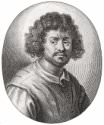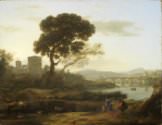Claude Lorrain
Claude Lorrain
Claude, whose real name was Claude Gellée, was born in the Vosges region of northeastern France, then part of the Duchy of Lorraine, from which he derived his nickname. It is not clear whether he trained first as a baker or an artist, but in the early 1620s he was in Italy. He was probably first taught in Naples (ca. 1620) by the German-born Goffredo Wals and then in Rome by Agostino Tassi, from 1622 to 1625. In the early 1730s, he was patronized by Cardinal Bentivoglio and then by the Pope, which established his reputation, and he has been associated with Rome and the countryside around it (the “Campagna”) ever since. The fact that Claude lived in the area around the Spanish Steps remained significant for subsequent generations of artists, who also tended to settle in that part of the city. He was one of the most influential of all landscape painters, chiefly on account of the quality of the “golden light” that suffuses so many of his paintings, but he was also a master of composition. In common with other landscape artists of the time, he rarely if ever painted a scene that was topographically accurate, instead assembling an ideal composition from motifs that he studied from nature. In this practice he was true to theories enshrined in the royal French academy, and most of his landscapes are ostensibly an interpretation of incidents in the classical or biblical past, which elevated them above the lowly status usually accorded to the genre. It was Richard Wilson’s explicit aim “to rival Claude,” while John Constable spoke of Claude’s landscapes as expressing “the calm sunshine of the heart.”

